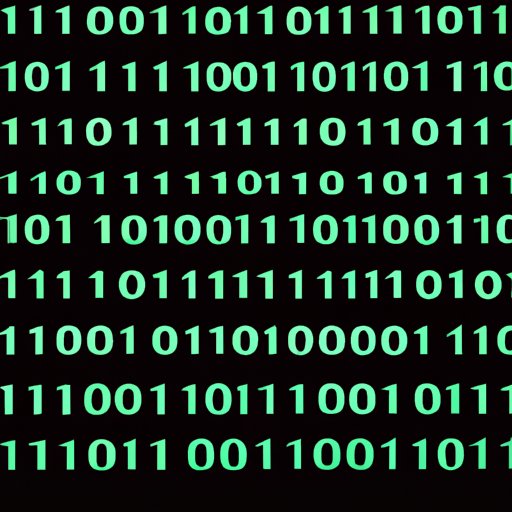I. Introduction
Are you struggling to understand how binary and hexadecimal numbers work? Do you want to be able to convert binary to hexadecimal with ease? Then, this article is for you. In this guide, we’ll explain the relationship between binary and hexadecimal numbers and teach you a straightforward method to convert binary numbers to hexadecimal. This article is aimed at anyone who wants to learn more about the fascinating world of computer science.
II. Understanding Binary, Decimal, and Hexadecimal
Before we jump into the conversion process, let’s briefly go over what binary, decimal, and hexadecimal numbers are and why hexadecimal is essential in computer science.
Binary is a number system with two unique digits, 0 and 1. It is the foundation of all digital electronics and the language of computers. Each binary digit, or bit, represents a power of two. For example, the binary number 1101 represents 13 in decimal.
Decimal is a base-10 numbering system that uses ten unique digits, 0 to 9. We are most familiar with this number system since it is the one we use daily. Each decimal digit represents a power of ten. For example, the decimal number 583 is obtained by adding 5 times 100, 8 times 10, and 3 times 1.
Hexadecimal is a base-16 numbering system that uses sixteen unique digits, 0 to 9 and A to F. Each hexadecimal digit represents a power of 16. Hexadecimal is essential in computer science because it represents binary numbers efficiently. Since computers store and process data in binary, having a way to represent binary numbers in a compact way makes programming much more manageable.
III. Step-by-Step Guide for Converting Binary to Hexadecimal
The conversion process from binary to hexadecimal is simple. Follow these easy steps:
Step 1:
Divide the binary number into groups of four from right to left.
Step 2:
Add zeros to the leftmost group to make it a four-digit group.
Step 3:
Write down the corresponding hexadecimal value of each four-digits group. For example, 0001 is equal to 1 in hexadecimal, 1010 is equal to A in hexadecimal, and 1111 is equal to F in hexadecimal.
Step 4:
Combine the hexadecimal values obtained in step three.
Let’s use the binary number 11010111 as an example. This number can be separated into two groups of four: 1101 and 0111. We add a 0 to the leftmost group to make it a four-digit group: 1101 and 0111 becomes 1101 0111. Next, we find the hexadecimal value of each group. 1101 is equal to D in hexadecimal, and 0111 is equal to 7 in hexadecimal. We combine D and 7, and we obtain the hexadecimal value of the binary number 11010111, which is D7.
IV. Tips and Tricks for Converting Binary to Hexadecimal
Here are some tips to make the binary to hexadecimal conversion process quicker and more efficient:
Tip 1:
Instead of grouping the binary digits into fours, try grouping them into threes or twos. The conversion process is still the same, but it requires less padding with zeros.
Tip 2:
Use a table that displays the binary, decimal, and hexadecimal equivalents of all possible four-digit binary numbers. This table can help you identify the hexadecimal value of each group quickly.
V. Binary to Hexadecimal Cheat Sheet
If you frequently convert binary to hexadecimal, it may be useful to have a simple and concise guide to help you. Here is a cheat sheet that you can use:
Step 1:
Divide the binary number into groups of four from right to left.
Step 2:
Add zeros to the leftmost group to make it a four-digit group.
Step 3:
Find the hexadecimal equivalent of each four-digit group.
Step 4:
Combine the hexadecimal values obtained in step 3.
VI. The Importance of Hexadecimal in Computer Science
Hexadecimal is crucial in programming, particularly in low-level programming languages like assembly language, which directly communicates with the computer’s hardware. One example of its use is in web color codes, which are written with hexadecimal values. Binary also plays a significant role in computer hardware because computers store and process data in binary.
VII. Exercises for Practicing Binary to Hexadecimal Conversion
Now that you’ve learned how to convert binary to hexadecimal, it’s time to test your skills. Here are some exercises that you can try:
1. Convert the binary number 10110110 to hexadecimal.
2. What is the hexadecimal equivalent of the binary number 111000010101?
3. Convert the binary number 1001101101 to hexadecimal.
4. What is the hexadecimal equivalent of the binary number 101010111000?
5. Convert the binary number 110000010011 to hexadecimal.
Solutions:
1. B6
2. E0A5
3. 319
4. A78
5. C19
VIII. Conclusion
In conclusion, binary and hexadecimal numbers are vital components of computer science. In this article, we have provided a detailed guide to converting binary to hexadecimal and discussed the importance of hexadecimal in programming. With enough time and practice, anyone can master this skill. We hope this article has been informative, and we encourage you to practice your binary to hexadecimal conversion skills.
